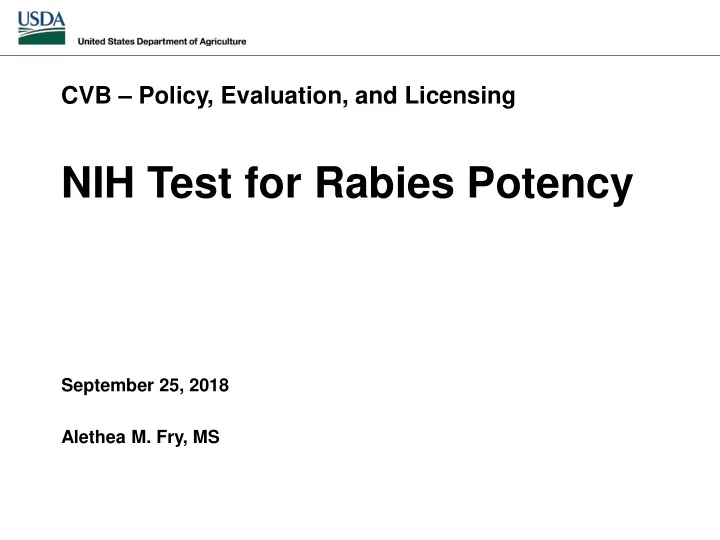

CVB – Policy, Evaluation, and Licensing NIH Test for Rabies Potency September 25, 2018 Alethea M. Fry, MS
NIH Background Developed in 1953, the NIH method meets the minimum standards for achieving compliance with US potency test regulations and establishes minimum recommended batch potency requirements (Barth et al., 1988, Wunderli et al., 2003a, CFR, 2011).
NIH Test Components/Considerations Reference vaccine Challenge virus Test serials (1-3) Animals
Reference Vaccine • Lot of BPL inactivated rabies vaccine • Collaborative studies with veterinary firms
Challenge Virus Standard • Strain – CVS-11 • Tested in accordance with 9CFR 113.55, 113.27 and 113.28 • Identity confirmation
Test Serials • Requests from Review team – Prelicense testing • Testing based upon Inspection and Compliance requests • Routine check and stability testing
NIH Test - Animals Animals Test groups • Animals weigh between • 4-5 groups to test 4-5 11-13 grams at arrival doses of the reference • Typically weigh 13-16 vaccine grams at first vaccination • 5 groups to test 5 doses • A minimum of 200 mice of the test vaccine. are required to test 1 • 4 groups to test CVS serial (back titration of • Test multiple lots (3) challenge virus) simultaneously to reduce animal usage
Vaccination of Animals Mice are vaccinated by the intraperitoneal route with 0.5 mL of test vaccine or reference preparation on Day 0 and Day 7.
Challenge Virus Standard (CVS) 7 days after the second vaccination mice are inoculated with a challenge dose of CVS Virus (≥12 LD 50 per 30µL) Prepare three 10-fold dilutions (10 -1 , 10 -2 and 10 -3 ) to conduct a titration of the working CVS range.
Refinement - Use of Anesthesia • CVB has incorporated the option of using general anesthesia in the NIH test Rodent general anesthesia machine . Isoflurane with a calibrated vaporizer
NIH Test for Rabies Potency Mice are observed twice each day daily for 14 days for rabies infection or death Mice which die prior to or on day 5 post-challenge are considered nonspecific deaths. Animals that die or have clinical signs of rabies infection 6 -14 days post-challenge are considered as positive for rabies infection Rabies disease in mice can be recognized in 5 stages based upon work by Bruckner (Bruckner et.al 2003).
Animals which exhibit stage 3 or greater are humanely euthanized. SAM 308 Outlines these stages Stage 1: Ruffled fur and hunched back Stage 2: Slow or circular movements Stage 3: Shaky movements, trembling and convulsions Stage 4: Signs of paralysis Stage 5: Moribund animals Mice which survive the 14-day post challenge observation are humanely euthanized.
Test validity Tests are considered valid if at least 70% of immunized mice receiving the lowest dilution (highest dose) of vaccine survive. 70% of mice receiving the highest dilution (lowest dose) of vaccine die (lowest dose) of vaccine die
Calculations for serial potency ED 50 of each test vaccine, reference and the LD 50 of the CVS Relative Potency of the test vaccine is determined
Questions
Recommend
More recommend